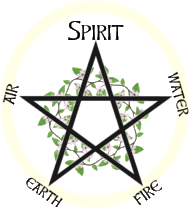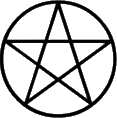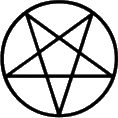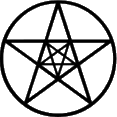| The Pentagram |
| by Steven |
 |
The pentagram, a five pointed star within a circle, is not only the symbol of Wicca, but also an ancient character used by the ancient Egyptians, Indians, Persians and Greeks, among others, and has become a favorite magickal symbol for many Neopagans, ceremonial magicians, and general new-age types. While one could easily write chapters on the various origins and nifty facts about the symbol, I'll try to keep this realitively brief. For a more in-depth history and mythology of the pentagram, visit The Witches' Pentacle over at the WVOX. |
The number five also corresponds to the main points of the human body, the head, arms, and legs, and thus is a symbol of humanity. Also, being in a wheel-format, with spokes that radiate from a central point, with a circle encompassing them, gives the pentagram the quality of constant motion, moving forward, and timelessness. The wheel analogy also figures in with the cyclic nature of life. The star pointing upwards is also important, as it represents the mind, spirit, and divine forces over the earthly elements, while at the same time being part of the same shape. In this way the divine is, perhaps, a bit loftier an idea than soil and the air, but nonetheless still a knowable and accessible part of life. This contrasts with the typical religious notion of the divine and everyday life as being separate from, if not in opposition to one another. |
||
Also significant is that, in the inverted pentagram, it is the four elements which are above the spirit point. This makes it a powerful symbol of grounding and material goals. The symbol also can be used in banishing and negative magick. It is important to remember that in Wicca turning a symbol upside-down does not mean reversing it, but rather it allows us to view it from another perspective. Though we recognize that the inverted pentagram is not solely a symbol of evil, it has a very bad stigma about it, so they are rarely worn or displayed in public, just so people don't get the wrong idea. |
||
|
|


 As
Above So Below,
a phrase you are bound to come across at some point, refers
to the polarity present in life and nature. Though male and
female, day and night, and life and death are all total opposites,
they are still equal, and neither is entirely good or evil,
and neither can exist without the other. This ever-present
duality is represented in the symbol at your right, a upright
pentagram with an inverted star at its center. It is essentially
the Wiccan equivalent of the eastern Yin and Yang.
As
Above So Below,
a phrase you are bound to come across at some point, refers
to the polarity present in life and nature. Though male and
female, day and night, and life and death are all total opposites,
they are still equal, and neither is entirely good or evil,
and neither can exist without the other. This ever-present
duality is represented in the symbol at your right, a upright
pentagram with an inverted star at its center. It is essentially
the Wiccan equivalent of the eastern Yin and Yang.
